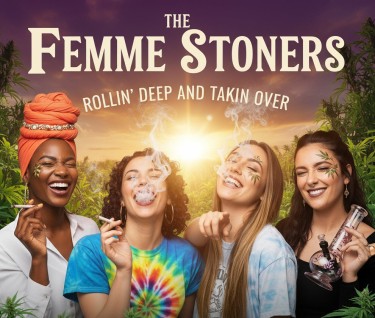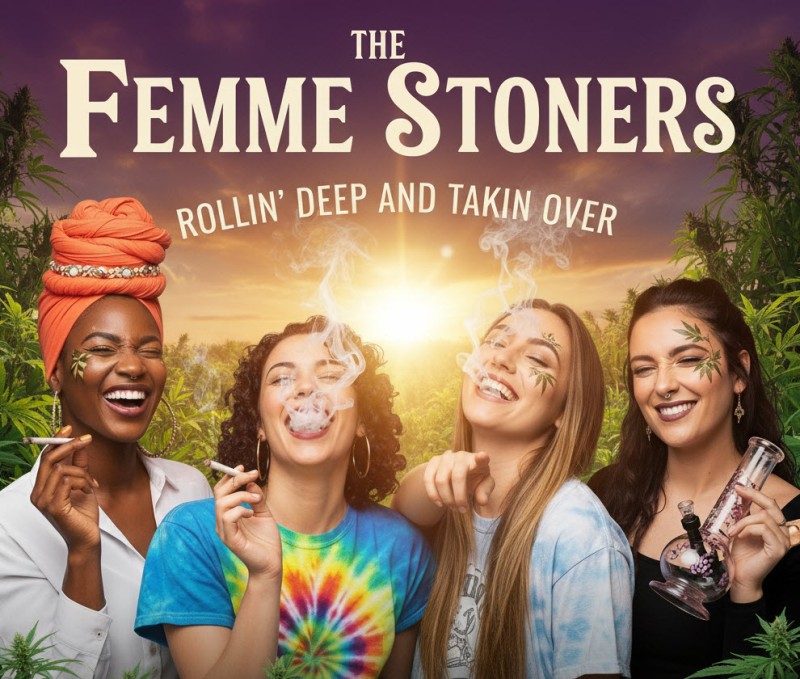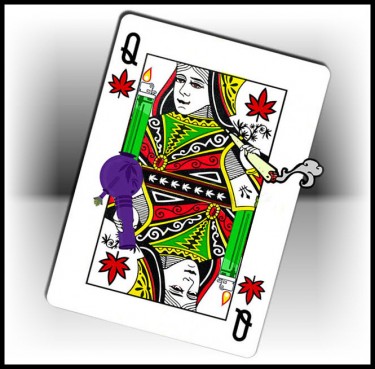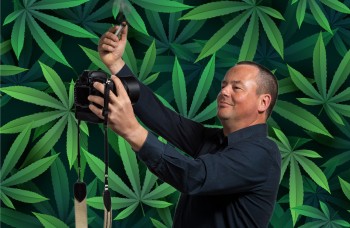
For fifty years, the image of the typical cannabis user was carved in stone: male, slacker, probably unemployed, definitely hungry. From Cheech and Chong to Pineapple Express, stoner culture was a boys' club with occasional female sidekicks. But 2024 just shattered that stereotype with data that would make Hollywood rewrite every cannabis comedy.
For the first time in half a century of tracking, girls now use marijuana significantly more than boys in every grade level. This isn't a statistical blip – it's a seismic shift that nobody saw coming, except maybe Anna Faris in the 2007 film "Smiley Face," which now looks less like stoner comedy and more like prophetic cinema.
The numbers tell a remarkable story. According to the 2024 Monitoring the Future report, female high school students are outpacing their male counterparts in marijuana use across all grades, with the gap widening as students get older. By 12th grade, the difference is substantial and growing. The driving force? Vaping – that discreet, flavorless, rainbow-colored gateway that's made cannabis consumption as socially acceptable as sipping a latte.
This shift isn't happening in a vacuum. It coincides with rising rates of anxiety and depression among teenage girls – 57% report persistent sadness compared to 29% of boys. Meanwhile, 40 states have legalized medical marijuana, normalizing cannabis as medicine rather than just recreation. For girls dealing with everything from menstrual cramps to social media-induced anxiety, a discreet vape pen offers relief without the stigma of traditional smoking.
The implications extend far beyond consumption statistics. We're witnessing the potential feminization of cannabis culture, and that means everything changes – from product development to marketing strategies to the very way we think about weed. If women are becoming the primary consumers, expect cannabis companies to start thinking more like cosmetics brands and less like head shops.
The stoner bro era is ending. The femme stoner revolution has begun. And just like Anna Faris stumbling through Los Angeles high as a kite, the cannabis industry is about to discover that when women embrace something, they don't just consume it – they transform it entirely.
From Smiley Face to Real Faces: The Prophetic Vision of Female Cannabis Culture
Back in 2007, "Smiley Face" bombed at the box office. Critics dismissed it as another dumb stoner comedy, audiences ignored it, and Anna Faris's portrayal of Jane F – a chronically high actress stumbling through a day-long cannabis adventure – seemed like a one-off curiosity in a genre dominated by male protagonists.
But rewatching "Smiley Face" today feels like discovering a lost prophecy. While Hollywood was churning out "Pineapple Express" and "Harold & Kumar," this overlooked film was quietly depicting something revolutionary: a female stoner who wasn't a punchline or a prize, but the actual protagonist of her own cannabis journey.
Jane F wasn't the girlfriend getting high to impress her boyfriend, or the party girl using weed for wild adventures. She was a fully realized character whose relationship with cannabis was complex, personal, and distinctly feminine. Her high wasn't about bros bonding over bongs – it was about managing anxiety, creative expression, and navigating the mundane absurdities of modern life.
The film's approach to cannabis consumption was also prophetic. Jane's edibles mishap feels remarkably contemporary given today's market dominance of discrete consumption methods. No smoking circles or elaborate glass pieces – just accidental overconsumption of homemade goods, leading to a day of introspective chaos that somehow resolves into self-discovery.
What made "Smiley Face" different was how it portrayed the female cannabis experience without male validation or judgment. Jane wasn't rebelling against anyone or trying to prove anything. She was simply living her life, using cannabis as a tool for managing reality rather than escaping it. This authentic portrayal of female stoner culture felt alien in 2007 but reads as completely natural today.
The film also captured something crucial about female cannabis users that current data supports: they're not using it primarily "to get high" or "for fun" like their male counterparts. Jane's cannabis use was functional, emotional, and deeply integrated into her daily existence. She wasn't performing stoner culture – she was inhabiting it.
Fast-forward to 2024, and Jane F looks less like an outlier and more like a demographic trend. The discreet consumption methods, the anxiety management, the creative expression, the everyday integration – these elements that seemed quirky in a 2007 comedy now represent the mainstream female cannabis experience.
Hollywood missed the memo then, but they can't ignore it now. The current crop of cannabis comedies still skews heavily male, but that's about to change. When an entire demographic shifts toward your product, entertainment follows. Expect the next wave of cannabis content to look a lot more like "Smiley Face" and a lot less like "Pineapple Express."
Anna Faris may have been ahead of her time, but time has caught up. The femme stoner isn't coming – she's already here, vape pen in hand, anxiety managed, and ready to redefine what cannabis culture looks like. "Smiley Face" wasn't just a movie; it was a preview of the future.
The Biology Behind the High: Why Women's Bodies Embrace Cannabis
The shift toward female cannabis dominance isn't just cultural – it's biological. Women's bodies are literally designed to respond more intensively to cannabis, and understanding this physiology explains why girls are increasingly turning to weed while boys stick to more traditional substances.
The endocannabinoid system, our body's natural cannabis network, operates differently in female bodies. Women have higher concentrations of cannabinoid receptors in crucial brain regions including the hippocampus, striatum, and amygdala. This means when women consume THC, they're not just getting higher – they're getting a fundamentally different neurological experience.
Estradiol, the primary female sex hormone, amplifies this effect by increasing dopamine release in response to THC. This creates a more rewarding experience that can lead to faster habituation and, unfortunately, quicker development of tolerance. But it also explains why women often report more pronounced therapeutic effects from cannabis, particularly for anxiety, pain, and mood disorders.
This biological sensitivity intersects perfectly with the mental health crisis affecting teenage girls. With 57% of high school girls reporting persistent sadness compared to 29% of boys, and double the rates of anxiety and depression, cannabis offers relief that traditional medications often fail to provide. The discrete nature of vaping makes it particularly appealing to girls who might avoid smoking due to social stigma or health concerns.
The hormonal connection runs deeper than just brain chemistry. Women's monthly hormonal fluctuations create windows where cannabis becomes particularly effective for managing symptoms. Many women report that cannabis helps with menstrual cramps, mood swings, and the general discomfort of hormonal cycles – applications that simply don't exist for male users.
There's also the appetite factor, though not in the way most people think. While the "munchies" stereotype suggests cannabis increases appetite, many women use it for the opposite effect. Low-dose cannabis can actually suppress appetite and reduce food cravings, particularly appealing to girls dealing with body image issues or eating disorders. It's a complex relationship that highlights how gender differences in cannabis effects go far beyond simple consumption patterns.
The social media generation faces unique pressures that cannabis seems uniquely suited to address. The constant comparison, cyberbullying, and performance anxiety that particularly affect girls create a perfect storm of stress that traditional coping mechanisms don't adequately address. Cannabis, particularly in discrete vaping form, offers immediate relief without the social stigma of prescription medications.
But here's where biology meets marketing opportunity: women's enhanced cannabinoid sensitivity means they need different products than men. Lower-dose formulations, specific terpene profiles, and consumption methods designed for discrete use aren't just preferences – they're biological necessities.
The cannabis industry is slowly catching on. Products marketed to women emphasize wellness over recreation, featuring elegant packaging, precise dosing, and targeted effects. It's not just about getting high – it's about functional enhancement of daily life.
This biological reality explains why the gender flip in cannabis use might be permanent rather than cyclical. When your body is naturally designed to benefit more from a substance, and that substance helps address gender-specific health challenges, adoption becomes inevitable rather than trendy.
The Sticky Bottom Line: Pink Kush and Market Revolution
The feminization of cannabis culture represents more than just shifting demographics – it's a complete market revolution waiting to happen. When women embrace a product category, they don't just consume it; they transform it entirely.
Look at how women reshaped industries like fitness, beauty, and even alcohol. What started as male-dominated markets evolved into sophisticated ecosystems of targeted products, premium experiences, and lifestyle integration. Cannabis is next.
Expect the head shop aesthetic to give way to something resembling high-end wellness boutiques. Products will emphasize precise dosing, specific effects, and discrete consumption. Marketing will shift from "getting baked" to "functional enhancement" and "self-care ritual." The stoner bro will be replaced by the wellness goddess.
This isn't just speculation – it's economics. Women control roughly 80% of household purchasing decisions and are willing to pay premium prices for products that meet their specific needs. A cannabis industry that caters to female physiology, concerns, and consumption preferences isn't just smart business – it's inevitable.
The data from 2024 might mark the tipping point, but the trend has been building for years. From CBD beauty products to microdosed edibles, the cannabis industry has been unconsciously preparing for female dominance.
Anna Faris was ahead of her time in "Smiley Face," but the industry is catching up fast. The dawn of the femme stoner isn't coming – it's already here, vape pen in hand, anxiety managed, ready to spend money on products designed specifically for her biology and lifestyle.
The future of cannabis isn't just female – it's profitable.







